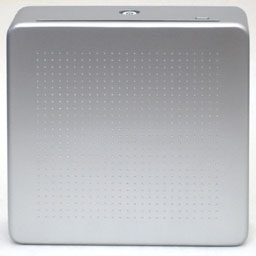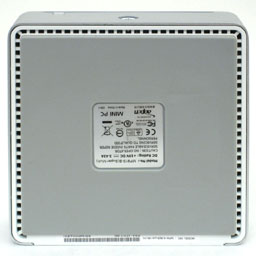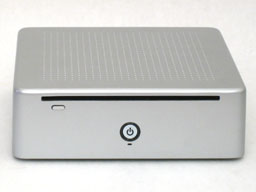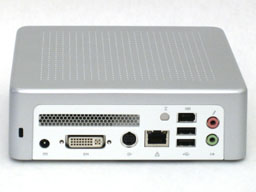Updated: AOpen MiniPC – Imitation is the Sincerest Form of Flattery
by Jarred Walton on March 3, 2006 12:05 AM EST- Posted in
- Systems
Appearance and System Specifications
To say that the AOpen MiniPC looks similar to the Mac Mini is an understatement. AOpen's own product marketing material contains numerous photographs comparing the two. Not everyone thinks that tiny PCs are cool looking or even necessary, but for those who do, the AOpen MiniPC is a very nice looking unit. Depending on where you purchase the MiniPC, you can find them in a variety of colors. Black, white, and silver are the most common, and the unit that we received is silver.
Other than the rear ports and the glowing blue power/HDD lights on the front, the case is a uniform silver. Also found on the front of the unit is the slot-load optical drive access and the accompanying eject button. The top has a grid of small indentations to add a bit of visual flare, while the sides and front are unadorned brushed aluminum. The bottom of the case has a rubberized non-slip pad with venting around the edges and a sticker containing product details, and that's about it. The case is, of course, very small, and you could easily hide it from view if desired, just like the Mac Mini. Technically, the MiniPC is slightly smaller than the Mac Mini (by about .5" in height), but basically, the system size is a tie.
One item that needs to be pointed out is the choice of interface. There are no legacy ports on the system; other than video and audio connections, the only interface for input devices and other components is provided by two USB 2.0 ports. Only two? That's right: if you want more than two devices, you're going to need a USB hub of some form. In fact, since you're going to use a mouse and keyboard for at least one port, a USB hub is almost required for expansion. You might try getting a keyboard with a couple of USB ports, but most likely, they will be USB 1.1, so you won't want to use them for high bandwidth devices. For testing, a Logitech Bluetooth keyboard and mouse combo was used, so that did leave a spare USB port. If you want to do anything more with the MiniPC, grab a powered USB 2.0 hub with at least four ports; they typically cost around $10 to $30, so it's not a major expense.
The Realtek ALC655 audio chip in the unit is capable of 5.1 sound, but apparently lack of room for the audio ports leaves only a speaker/headphone jack and a microphone jack. That should allow for up to 4.1 sound, using the microphone port for the rear/side speakers, but most users will either want 5.1 or 2.1 so the inclusion of only two audio jacks is a definite limitation. The unoccupied spot to the left of the USB/Firewire port is for the WiFi antenna, and it seems like AOpen could have added a third audio jack without too much difficulty, as there is still a bit of open space on the back plate. To the left of the plate you can see the exhaust port for the CPU HSF, and along the bottom are the DVI port, TV-out, LAN, and power sockets.
The TV-out takes an "octopus" adapter that splits the output into S-VIDEO, Component, or Composite, and a DVI to VGA adapter is included in the package. Both the component and DVI connections were tested with an HDTV, and the component was found to be preferable (as the DVI port would lose resolution settings between reboots). Notably lacking is support for S/PDIF output and legacy PS/2 ports for the keyboard and mouse. The audio overall is the weakest link, but the video aspects do help make up for it.
While the size and appearance may be similar to the Mac Mini, the insides are quite different. In typical Wintel fashion, AOpen has cloned the original Mac Mini with a system that is going to be faster in nearly every area. Here are the specifications.
If you're looking for a screaming fast computer, this isn't it. If you want to play a lot of games, once again, you're barking up the wrong tree. Taking all of the functionality in your standard computer and compressing it into a size that's about as big as your typical 5.25" DVD ROM drive requires some compromises. You get integrated graphics, a 2.5" hard drive, DVD burner, a processor and memory... and that's really about it. There is an option to have a WiFi card installed as well. The good news is that there are plenty of applications that don't require anything more than those specs.
One item that we have to clarify is that the system we received came with a Pentium M 740 (1.733 GHz Dothan) processor, and most of the online models as well as AOpen's documentation list the Pentium M 740 as the standard "high-end" processor. However, it appears that the system is capable of running faster CPUs, as there are a few European sites selling the MP915 with up to a Pentium M 760 (2.0 GHz). We didn't encounter any heat-related issues during testing, so other than cost there shouldn't be any reason for the MiniPC to not support the top Pentium M chips.
To say that the AOpen MiniPC looks similar to the Mac Mini is an understatement. AOpen's own product marketing material contains numerous photographs comparing the two. Not everyone thinks that tiny PCs are cool looking or even necessary, but for those who do, the AOpen MiniPC is a very nice looking unit. Depending on where you purchase the MiniPC, you can find them in a variety of colors. Black, white, and silver are the most common, and the unit that we received is silver.
Other than the rear ports and the glowing blue power/HDD lights on the front, the case is a uniform silver. Also found on the front of the unit is the slot-load optical drive access and the accompanying eject button. The top has a grid of small indentations to add a bit of visual flare, while the sides and front are unadorned brushed aluminum. The bottom of the case has a rubberized non-slip pad with venting around the edges and a sticker containing product details, and that's about it. The case is, of course, very small, and you could easily hide it from view if desired, just like the Mac Mini. Technically, the MiniPC is slightly smaller than the Mac Mini (by about .5" in height), but basically, the system size is a tie.
 |
 |
| Click on images to enlarge. | |
One item that needs to be pointed out is the choice of interface. There are no legacy ports on the system; other than video and audio connections, the only interface for input devices and other components is provided by two USB 2.0 ports. Only two? That's right: if you want more than two devices, you're going to need a USB hub of some form. In fact, since you're going to use a mouse and keyboard for at least one port, a USB hub is almost required for expansion. You might try getting a keyboard with a couple of USB ports, but most likely, they will be USB 1.1, so you won't want to use them for high bandwidth devices. For testing, a Logitech Bluetooth keyboard and mouse combo was used, so that did leave a spare USB port. If you want to do anything more with the MiniPC, grab a powered USB 2.0 hub with at least four ports; they typically cost around $10 to $30, so it's not a major expense.
The Realtek ALC655 audio chip in the unit is capable of 5.1 sound, but apparently lack of room for the audio ports leaves only a speaker/headphone jack and a microphone jack. That should allow for up to 4.1 sound, using the microphone port for the rear/side speakers, but most users will either want 5.1 or 2.1 so the inclusion of only two audio jacks is a definite limitation. The unoccupied spot to the left of the USB/Firewire port is for the WiFi antenna, and it seems like AOpen could have added a third audio jack without too much difficulty, as there is still a bit of open space on the back plate. To the left of the plate you can see the exhaust port for the CPU HSF, and along the bottom are the DVI port, TV-out, LAN, and power sockets.
The TV-out takes an "octopus" adapter that splits the output into S-VIDEO, Component, or Composite, and a DVI to VGA adapter is included in the package. Both the component and DVI connections were tested with an HDTV, and the component was found to be preferable (as the DVI port would lose resolution settings between reboots). Notably lacking is support for S/PDIF output and legacy PS/2 ports for the keyboard and mouse. The audio overall is the weakest link, but the video aspects do help make up for it.
While the size and appearance may be similar to the Mac Mini, the insides are quite different. In typical Wintel fashion, AOpen has cloned the original Mac Mini with a system that is going to be faster in nearly every area. Here are the specifications.
| AOpen MiniPC MP915 | |
| Motherboard: | AOpen propietary 915GM+ICH6M |
| Processor: | Intel socket 479 (Celeron M to Pentium M 740) |
| RAM: | 1 X DDR2 SO-DIMM (Maximum 1GB of RAM) |
| Hard Drive: | 2.5" PATA Notebook HDD |
| Graphics: | 915GM (Intel GMA900) |
| Optical Drive: | Slim CD/DVD slot load |
| Expansion Slots: | 1 X Mini-PCI (for WiFi) |
| Audio: | Realtek ALC655 AC'97 2CH (Speaker/Headphones + Microphone) |
| Power Suply: | 65W (19V, 3.5A) External Adapter Internal connections from motherboard to HDD and ODD |
| Front Ports: | None. Power Button, HDD Activity LED, ODD Eject Button |
| Rear Ports: | 2 X USB2.0 2 X 3.5mm Audio (speakers and microphone) LAN (GbE) 1 X DVI-D and 1 X TV-Out (S-VIDEO, Composite, Component) 1 X Optional WiFi Antenna |
If you're looking for a screaming fast computer, this isn't it. If you want to play a lot of games, once again, you're barking up the wrong tree. Taking all of the functionality in your standard computer and compressing it into a size that's about as big as your typical 5.25" DVD ROM drive requires some compromises. You get integrated graphics, a 2.5" hard drive, DVD burner, a processor and memory... and that's really about it. There is an option to have a WiFi card installed as well. The good news is that there are plenty of applications that don't require anything more than those specs.
One item that we have to clarify is that the system we received came with a Pentium M 740 (1.733 GHz Dothan) processor, and most of the online models as well as AOpen's documentation list the Pentium M 740 as the standard "high-end" processor. However, it appears that the system is capable of running faster CPUs, as there are a few European sites selling the MP915 with up to a Pentium M 760 (2.0 GHz). We didn't encounter any heat-related issues during testing, so other than cost there shouldn't be any reason for the MiniPC to not support the top Pentium M chips.












54 Comments
View All Comments
plinden - Friday, March 3, 2006 - link
Yeah, when are we getting the ability to edit our posts?siliconthoughts - Friday, March 3, 2006 - link
When a genuine mac mini costs less, is more upgradeable (dual core, 2 DDR slots, digital audio, WiFi, Bluetooth, 4 USB ports, faster graphics) comes with a nifty secure OS and includes a whole suite of apps, why would anyone buy this? XP just isn't that great that I'd spend a $300 premium for it on an inferior box.Googer - Friday, March 3, 2006 - link
These are nice, but It is my suspicion that a Turon in an Mini PC would be the faster choice.NegativeEntropy - Saturday, March 4, 2006 - link
Agreed -- a Turion "version" would be interesting. That said, I think this statement from the review could use a bit of modifying:"...if you really want low power, you can go with one of the Pentium M platforms. End of discussion. "Tech Report recently found that the Turion can compete pretty well with the PM on power consumption http://techreport.com/reviews/2006q1/pentiumm-vs-t...">http://techreport.com/reviews/2006q1/pentiumm-vs-t...
JarredWalton - Saturday, March 4, 2006 - link
This isn't meant as a far-reaching statement. What I'm talking about is small form factors, or systems that will compete with the MiniPC. Turion support on socket 754 platforms is lacking, meaning that there are boards that support it but there are definitely boards that won't support it. Most of the socket 754 small form factors are pretty old, so I don't know how many of them would support Turion.The article at Tech Report is interesting, but idle power draw is only half of the question. 94 W at full load really isn't that much better than the rest of the Athlon 64 line. I mean, the HP DX5150 with an old ClawHammer core running at 2.4 GHz is only about 20 W higher. If you were to use a 90 nm Athlon 64, that would cut off 10 W or so right there.
Basically, the Athlon 64 design is really good, and it doesn't require all that much power. However, it still can't really compete with the Pentium M. when you shift to laptops, the whole system probably doesn't consume more than 45 W, so 20 W more for the processor is a major deal. Using desktop systems to try and determine laptop suitability is definitely not the best way to go about it. Ideally, you would want identical laptops, with the only difference being motherboard, chipset, and memory. But that's a story for another day.
Googer - Friday, March 3, 2006 - link
I would love to see this Aopen MINI PC rebench marked with a Pentium M 733 or 753 Ultra Low Voltage Processor that has a Maximum of 5W TDP! I would love to see it compaired against the higher 27W TDP Pentium M 740 in both Power Consumtion and Application benchmarks.I bet that at full load the power usage on full load will drop from 38W (with 740) down to 16w and even lower at IDLE! (10W maybe?) With a processor like that this would be the perfect pc for those guys who like to intergrate computers with their cars. Bye bye VIA C3! (C3 Will have http://www.metku.net/index.html?sect=view&n=1&...">other uses though)
JarredWalton - Friday, March 3, 2006 - link
Actually, with the HDD and other components, the system is probably using around 18W for the system and 7 to 20W for the CPU. It might even be 20-22W for the system. Still, 38W at maximum load (i.e. HDD activity along with 100% CPU) is hardly going to tax a car, I don't think. (But I'm not a car A/V guy, so maybe I'm wrong.)michael2k - Friday, March 3, 2006 - link
You would think, with AOpen's resources, that the AOpen MiniPC would be cheaper than the more powerful and featureful Mac mini.What is AOpen doing that is making it more expensive? It's got an older chipset, slower CPU, less USB ports, no rewritable optical drive, no bluetooth, and no wireless networking.
It's an odd day when buying a Mac is cheaper AND more powerful.
Questar - Friday, March 3, 2006 - link
AOpen isn't isn't a computer manufacturer, they are a board maker. What could they do to bring down the price of a system?jconan - Friday, March 3, 2006 - link
It's the economy of scale! Apple definitely has this contract manufacturing capacity considering its hardware/software business as well as its distribution channels. AOpen is just a manufacturing firm and is not in the software business to install an in house OS and plus it doesn't have sufficient sales offices out in the distribution side to push its wares. They have to rely on major OEMs to buy in bulk quantity to leverage prices with them.